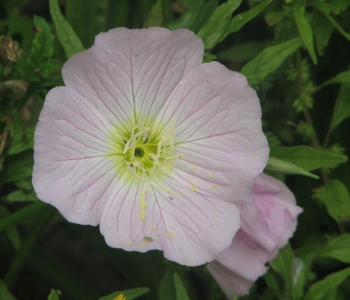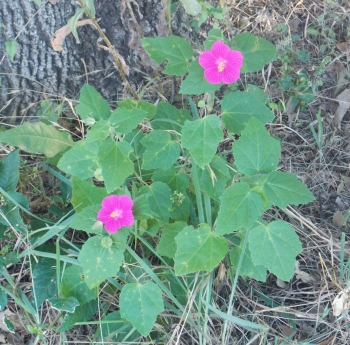Peach; Peach Tree Prunus persica;. Peaches originated in the “Mediterranean” climate of western China and eastern Persia, as the scientific name persica indicates. Wild Peaches will sometimes grow from pits of hybrid peaches, but otherwise they do not naturally propagate in this area. Called “clings”, the flesh clings to the seeds of wild peaches, rather than separating easily, as commercial hybrids do. However, the flowers and leaves look similar. Trees have smooth to scaly bark, and the long limbs tend to droop when laden with fruit, or sometimes even split apart from the trunk. The leaves are slightly folded, long and narrow, with very short petioles, with a pronounced drip-tip, and are born alternately along stems. Flowers form before new growth emerges, budding from leaf scars on last year’s stems. Dark red bud sepals open, allowing the five showy, pink petals to unfold, which like other members of the Rosacea family, sport a dome of filamentous stamen, each tipped with an anther, surrounding a central pistol. Fruit are hairy, scored by a central cleft, and have one hard, flattened pit with a convoluted surface. The sweet fruit are eaten by birds and wasps alike if left on trees too long. Like Almonds, the seed inside is laced with cyanide, making them taste bitter, and potentially poison if too many are eaten. (406-407) 3/5/16; 2/25/17 – 3/15/17; 18 no obs (drupe 5/24/18); 2/28/19 – 3/23/19 (drupe 6/22/19); 2/18/20 – 3/15/20 (drupe 6/12/20);
Peach habit; a readily branching, short tree with smooth to scaly bark.
Note; large, showy five petal, pink flowers with multiple filamentous stamen.



Note; flowers convert to fleshy drupe scored by a cleft, with a flattened, rough seed inside.

Note; alternating, narrow, deciduous, elongated leaves with finely serrated, slightly undulating margins partly obscure fruit

Note; the large fruit on short stems, bud directly from nodes along last years growth. hard, and reddish, and covered with fine fuzz, peaches will ripen and turn soft if picked when fully grown.




























